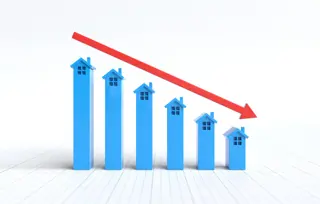Bhopal Sees an 8% Drop in Home Sales During Q1 2025
 The real estate scene in Bhopal has taken a noticeable hit this quarter, with housing sales slipping by 8% in the first three months of 2025. This decline aligns with a broader trend hitting Central and Eastern India, where housing sales volumes plunged 18% during the same period. While this paints a challenging picture for Bhopal, it's essential to contextualize these numbers within the overall dynamics of India's tier 2 cities.
The real estate scene in Bhopal has taken a noticeable hit this quarter, with housing sales slipping by 8% in the first three months of 2025. This decline aligns with a broader trend hitting Central and Eastern India, where housing sales volumes plunged 18% during the same period. While this paints a challenging picture for Bhopal, it's essential to contextualize these numbers within the overall dynamics of India's tier 2 cities.
Divergent Trends: Volume vs. Value
Despite the drop in unit sales across many tier 2 cities, including Bhopal, the sales value in these cities rose by 6% overall. This contrast indicates that while fewer homes sold, the average price per unit or the movement towards higher-value properties may be pushing sales values upward. The implication is a market adjusting to factors such as inflation, premium housing demand, or shifts in consumer preference.
Regional Insights: Central & Eastern India
- The Central and Eastern regions, encompassing Bhopal, experienced an 18% fall in housing sales volumes, underlining a softer demand or possible affordability concerns in these areas.
- Other tier 2 cities like Lucknow bucked the trend with significant growth (25%), hinting at varied regional performances within the same tier classification.
Factors Influencing Bhopal’s Market
The slowdown in Bhopal’s housing sales could be attributed to several intertwined factors:
- Economic Sentiment: As property prices continue to rise, buyers may choose to delay their purchases decisions.
- Inventory and Pricing: Existing inventory levels paired with rising home prices may be limiting the pool of buyers.
- Market Maturity: Bhopal’s market might be transitioning, with growth tapering after previous expansion phases.
What This Means for Stakeholders
- Buyers: For buyers, this dip could signal potential negotiating power and a broader choice as sellers adjust strategies.
- Developers: Builders might need to explore flexible pricing or innovative projects catering to emerging buyer profiles.
- Investors: The value rise despite sales volume decline suggests selective opportunities in premium segments.
Conclusion
Bhopal’s 8% drop in housing sales amidst an 18% regional decline reflects nuanced market conditions shaped by diverse economic and demographic forces. While the falling volume signals caution, the rising sales value across tier 2 cities demonstrates robust underlying demand for quality housing. Moving forward, monitoring price adjustments and demand drivers will be crucial for navigating this evolving landscape effectively.